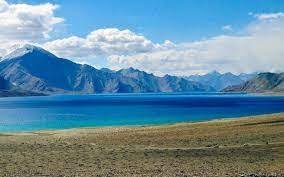Pangong Tour Packages
Planning a Pangong Tour Packages, one of the most beautiful and serene high-altitude lakes in the world, located in the Himalayas of Ladakh, India, requires careful consideration and meticulous planning. This guide will help you create a comprehensive and enjoyable Pangong Trip, covering everything from transportation and accommodation to permits and packing essentials.
Step 1: Research and Decide the Best Time to Visit
Pangong Lake is best visited between May and September when the weather is relatively warm, and the roads are clear of snow. During this time, the lake showcases its mesmerizing blue waters, and the temperature ranges between 5°C and 25°C. Winter visits are possible but not advisable due to extreme cold and heavy snowfall, which can make travel dangerous and uncomfortable.
Step 2: Plan Your Route
There are two popular routes to reach Pangong Lake:
- Leh to Pangong via Chang La Pass: This is the most common route, starting from Leh and passing through the scenic Chang La Pass. The distance is approximately 160 km, and the journey takes about 5-6 hours. The road conditions can be challenging, especially at the pass, so ensure your vehicle is well-equipped for high-altitude travel.
- Nubra Valley to Pangong via Shyok River or Wari La Pass: If you are already in Nubra Valley, you can take the route along the Shyok River or via the Wari La Pass. The Shyok River route is shorter but more rugged, while the Wari La route is longer but offers breathtaking views.
Step 3: Obtain Necessary Permits
Traveling to Pangong Lake requires an Inner Line Permit (ILP) for Indian citizens and a Protected Area Permit (PAP) for foreign nationals. These permits can be obtained online or from the DC office in Leh. Ensure to carry multiple copies of the permit as you will need to submit them at various checkpoints.
Step 4: Choose Your Mode of Transportation
You can reach Pangong Lake by various means, each offering a unique experience:
- Self-Drive Car/Bike: If you enjoy road trips, renting a car or bike from Leh can be an exhilarating way to explore the region. Ensure your vehicle is sturdy and has good ground clearance.
- Taxi: Hiring a taxi is a convenient option, especially if you are not comfortable driving on mountainous roads. Taxis can be shared or private, depending on your preference.
- Tour Packages: Many travel agencies offer Pangong Lake tour packages that include transportation, accommodation, meals, and permits. This is a hassle-free option for those who prefer a well-organized trip.
Step 5: Plan Your Accommodation
Accommodation options at Pangong Lake range from luxury camps to basic homestays. Here are some popular choices:
- Luxury Camps: These camps offer comfortable tents with attached bathrooms, running water, and electricity. Some popular options include Pangong Retreat Camp, Camp Watermark, and The Regal Camp.
- Standard Camps: These camps provide basic facilities, including tents with shared bathrooms. They are budget-friendly and offer a closer experience to nature. Options include Wonderland Camp and Himalayan Wooden Cottages.
- Homestays: For a more authentic experience, you can opt for a homestay in nearby villages like Spangmik or Man. This allows you to interact with locals and understand their way of life.
Step 6: Pack Wisely
Packing for Pangong Lake requires careful consideration due to the high altitude and remote location. Here’s a list of essentials:
- Clothing: Pack layers of warm clothing, including thermal wear, fleece jackets, windproof jackets, gloves, hats, and scarves. Even in summer, temperatures can drop significantly at night.
- Footwear: Sturdy, comfortable trekking shoes with good grip are essential for walking on rugged terrain.
- Medication: Carry a basic first-aid kit, altitude sickness medication, and any personal medications you may need. It’s advisable to consult a doctor before traveling to high altitudes.
- Toiletries: Bring your own toiletries, including biodegradable soap, shampoo, and wet wipes, as facilities may be limited.
- Sunscreen and Sunglasses: The high altitude means stronger UV rays, so protect your skin and eyes.
- Camera and Binoculars: Pangong Lake is incredibly photogenic, and you’ll want to capture its beauty. Binoculars can enhance your wildlife viewing experience.
Step 7: Plan Your Activities
Pangong Lake offers various activities to make your trip memorable:
- Photography: The lake’s changing colors, the surrounding mountains, and the clear night sky offer endless opportunities for photography.
- Bird Watching: Pangong Lake is a haven for bird watchers, with various species of migratory birds, including the Brahminy Duck and Bar-headed Goose.
- Stargazing: The clear skies at Pangong Lake are perfect for stargazing. If possible, carry a telescope to enhance the experience.
- Trekking: There are several trekking routes around Pangong Lake for those who enjoy hiking. Ensure you are acclimatized before attempting any strenuous activity.
Step 8: Understand Local Customs and Etiquette
Respect the local culture and customs of Ladakh. Here are some guidelines:
- Dress Modestly: Although it’s a tourist destination, it’s respectful to dress modestly, especially when visiting local villages and monasteries.
- Photography Etiquette: Always ask for permission before photographing locals, their homes, or religious sites.
- Environmental Responsibility: Pangong Lake is an ecologically sensitive area. Avoid littering, use biodegradable products, and follow the principle of “Leave No Trace.”
Step 9: Emergency Preparedness
Due to its remote location, it’s essential to be prepared for emergencies:
- Communication: Mobile network coverage is limited. Inform someone about your travel plans and expected return time.
- Weather Updates: Keep an eye on the weather forecast and be prepared for sudden changes.
- Local Contacts: Have contact information for local authorities, medical facilities, and your accommodation providers.
Step 10: Budgeting
Finally, plan your budget, considering the following expenses:
- Transportation: Include costs for renting a vehicle, fuel, and permits.
- Accommodation: Choose according to your budget, whether luxury camps or basic homestays.
- Food: Meals at camps and homestays are generally included in the package, but budget for snacks and extra meals.
- Activities: Allocate funds for any additional activities or experiences you wish to undertake.
By following these steps, you can plan a Pangong Tour Packages. Whether you’re seeking adventure, tranquility, or a cultural experience, Pangong Lake has something to offer for every traveler. Enjoy your journey to this breathtaking destination!




More Stories
Mahakumbh: The Greatest Gathering on Earth
Savoring Traditions on Georgia’s National Day
Reasons to Visit Dubai Parks and Resorts